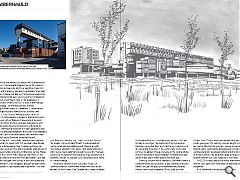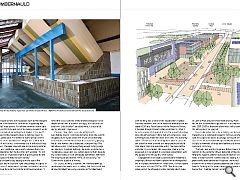Cumbernauld: Grey Area
30 Apr 2024
Urban Realm revisits Cumbernauld in the company of BBC Sounds to document the final years of the marmite new town’s unique town centre. Has the town been misjudged and what can it teach us about delivering places, not floor space? Photography by Chris Leslie.
Once feted as the shining city upon a hill Cumbernauld has been on a downward slide ever since its inception, culminating in moves by North Lanarkshire Council to be done with it entirely and erect a placeless ‘town hub’; in its stead. Paying one last visit to the town centre that time and taste forgot BBC Sounds podcast Hometown Boring and Urban Realm look at the qualities and characteristics of this concrete carbuncle that still get people talking - before they are lost forever. In a globalised world of sameness, Cumbernauld’s famed megastructure stands out as a sixties time machine of kitsch decor, liminal spaces and a lost ambition. Cumbernauld is a holdover from a brief post-war explosion of confidence in government to wield bricks and mortar to shock and awe populations and not simply create functional spaces as efficiently as possible.
Introducing the town to a new generation and challenging the preconceptions that come from repeated wins of the Carbuncle Award producer Anouska Lewis headed to Central Scotland to see for herself. Admitting that prior media coverage had coloured her expectations Lewis said: “I’d read old Urban Realm magazine articles saying how Cumbernauld was the most dismal town so I thought it would be a bit grey but I didn’t expect retail parks around the town centre. Those reminded me a lot of Milton Keynes. The inside of the shopping centre was another thing altogether. I got lost more than I thought I was going to and I was surprised at how difficult it is to navigate. I thought people might be a bit colder or less hopeful but they weren’t like that at all.”
Proving that community spirit is a stronger social glue than any masonry joint Lewis continued: “A lot of the people I spoke to said ‘What?! Cumbernauld isn’t boring, what are you talking about’. People are still town proud and optimistic about their community but I didn’t sense much optimism about the country. Younger people are more pessimistic because they’ve grown up in austerity. People my age are quite pessimistic and fearful of climate change.” Of greater concern is the disruptive impact of redevelopment at a time when many town centres are already on their knees. Can Cumbernauld retain its sense of identity? “Definitely”, declares Lewis. “The people are lovely and as much as they want a fresh start they are sad to see it go. The town’s identity is pinned on the town centre but they won’t let the community spirit die. Speaking to people in the community centre and community garden I hope everyone in the centre will be able to make sure it doesn’t happen for them but there will be a few years where people feel a bit lost.”
Charting the process of change is Concrete Dreams, a collective of artists dedicated to documenting the town centre through the eyes of its residents for posterity. Among them is photographer Chris Leslie who has turned his lens upon the ignominy of the failing centre in its final days: “Today when you wander through the town centre you sense the building has just fought and lost its last battle. Much of the original megastructure has been hidden under cladding for decades and several newer commercial units have been bolted onto it in an attempt at modernisation. The battleship grey is long gone, hidden beneath the colour palette of the 1980s. “In 2023 its long, empty corridors, worn exteriors and interior, look dated and from another botched universe altogether.” It’s a sentiment now accepted by Historic Environment Scotland who refused to step in and list the remaining structure, leaving bodies such as the Glasgow Institute of Architects as lone voices supporting the building’s repurposing. For all that common sense calls for the centre to be put out of its misery shouldn’t we be concerned about repeating the mistakes of the past?
Likening the megastructure to Optimus ‘past its’ Prime, Lewis said: “For better or worse people aren’t going to be as bold with the designs this time around. Maybe it will be less controversial but it will attract less attention. The New Town era was more about personal values and building a new society whereas this is just acknowledging that the building isn’t working. It’s not as hopeful as it was back then but sports grounds and green space will help the community.” It is a truism to say beauty is in the eye of the beholder, but in a specific light and perhaps a degree of intoxication Cumbernauld can claim a character all of its own, more than can be said for most new buildings. “I loved the colour scheme of the browns and greens and angles of the tiles. It is kitsch and ugly but I am a fan of that look. Ugly shouldn’t be a bad word, it is just a bit quirky and odd”, says Lewis.
Concept ‘town hub’ plans shared by North Lanarkshire Council and Ironside Farrar show the current megastructure swept aside with much of Central Way turned into a tree-lined boulevard incorporating playing fields, new homes and a dedicated transport hub. The ambitious vision offers everything except cutting-edge architecture. Counterintuitively the works are billed as a ‘sustainable, green and low-carbon regional hub’, despite the carbon costs of such wholesale demolition, with both Fleming House and former HMRC offices joining The Centre in the dustbin of history. Of course, nothing is definite until formal planning applications are made but it is telling that the council feel obliged to label their early concepts as ‘Cumbernauld’ with nothing else to anchor the visualisation in place. The only elements that will survive the transition are the giant ASDA and Tesco barns and the Antonine Centre, a faceless though modern retail environment.
What it lacks is a sense of character, lost in the pursuit of a clean slate though perhaps in time that will come once, long-suffering locals make the place their own. The authority notes: “These concepts are only illustrative so you can get a feel for what a mixed-use neighbourhood could look like on land size available within the town centre and what it could entail. But remember that any final proposals will be subject to extensive consultation with the people who will use the town centre.”
Engagement with local businesses and residents is ongoing to thrash out how to phase in the changes but the first phase demolition of Teviot Walk / Teviot Square is not expected until 2027 or 2028. The distinctive older part of the shopping centre spanning both sides of Central Way, around Tweed Walk and Tay Walk, will be the last element to go and this is not expected until 2031-2033 so there are a few years left to soak up the atmosphere for yourself. Even in denuded form, the surviving sections of the megastructure command respect if not love, prompting calls for steps to be taken to salvage some part of the structure such as the beached porthole penthouses as a sculptural reminder of what went before and so maintain continuity of history.
The bold new world of post-war Britain bears little relation to the austerity-driven demands of the present where the need to satisfy the needs of big-box retail takes precedence over novelty and risk- taking. Another plain vanilla town centre won’t capture the world’s attention in the way its predecessor has but it doesn’t have to. So long as the people who use the space are happy then it will be mission accomplished.
|
|





